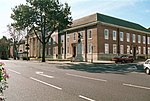Dome Cinema, Worthing

The Dome Cinema, Worthing, West Sussex, England, is a grade II* listed building owned by PDJ Cinemas Ltd. The Dome Cinema, which has three screens and a Projectionist's Bar is run by PDJ Cinemas, while Alfresco Services run two function rooms and the cafe at the front of the building. It has closed for refurbishment several times, most recently between December 2005 and July 2007. The name derives from the distinctive dome on top of a three-storey tower over the entrance. The Dome is an Edwardian building and one of the oldest working cinemas in England, and was opened in 1911 (Brighton's Duke of York's Picture House was opened in 1910). It was opened by Swiss impresario Carl Adolf Seebold. It was originally named The Kursaal — a German word translating as "cure hall". The Kursaal was used as a health centre and entertainment complex by visitors to the seaside town. At the time it contained the Coronation Hall, which was used for roller skating, exhibitions, concerts and events, and the Electric Theatre, the first cinema run for paying audiences in West Sussex. Following the outbreak of World War I leading residents of the town objected to the German name and after a competition with a prize of £1, the Cinema was renamed "The Dome".
Excerpt from the Wikipedia article Dome Cinema, Worthing (License: CC BY-SA 3.0, Authors, Images).Dome Cinema, Worthing
Marine Parade,
Geographical coordinates (GPS) Address Nearby Places Show on map
Geographical coordinates (GPS)
| Latitude | Longitude |
|---|---|
| N 50.81 ° | E -0.36805555555556 ° |
Address
The Dome Tea Room
Marine Parade 21
BN11 3PT
England, United Kingdom
Open on Google Maps










